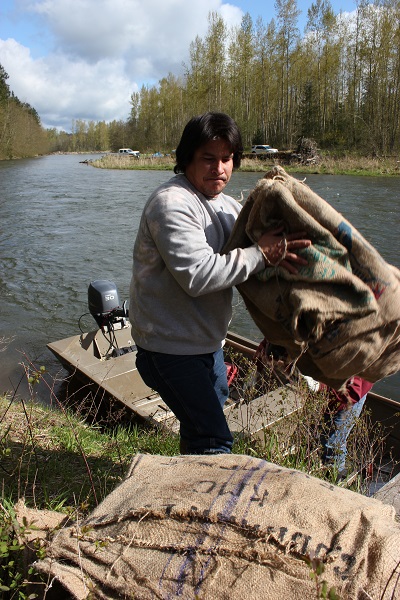Source: Northwest Indian Fisheries Commission

The Nisqually Indian Tribe is taking a creative approach to help a new streamside forest thrive.
“We’re using thousands of donated burlap sacks and transporting them across the Nisqually River by boat to make sure thousands of newly planted trees don’t get overrun by grass,” said David Troutt, natural resources director for the tribe. The tribe’s restoration planting crew recently reforested 15-acres of off channel habitat owned by the Nisqually Land Trust.
“Usually, we’d drive in with weed whackers and selectively use some herbicide to make sure the grass doesn’t take back over,” Troutt said. “But, this parcel is wet and remote, which means we had to take extreme measures.”
Much of the Land Trust property on the mainstem Nisqually is covered with water, so the tribe decided against traditional herbicide, because it might have spread downriver. Placing burlap sacks around the young trees prevents grass from crowding them out. Green Mountain Coffee Roasters in Sumner donated five pallets of used burlap sacks for the project.
After the initial work, the crew will return by boat every few weeks with weed whackers to take care of the plants they couldn’t put burlap around because they were too close to water. “We’ll have to maintain some plantings by hand because we’d probably see burlap sacks floating down the river if we tried to keep the grass down that way,” Troutt said.
The tribe employs a handful of tribal members on a planting crew that conducts and maintains salmon restoration planting projects across the watershed. Almost every habitat restoration project in the watershed has some element of planting and plant care. In just more than five years the crew has planted over 200,000 trees and shrubs.
Off-channel habitat is vital to the survival of young salmon, especially chinook, coho and steelhead. Those species can spend take more than a year before leaving for the ocean, so the quality of freshwater habitat is especially important. Both Nisqually chinook and steelhead are listed under the federal Endangered Species Act.
“Off channel areas give salmon a place to rest and feed during the winter when the mainstem of the river might be flooding, making it inhospitable for them,” Troutt said. “Hopefully, by restoring and protecting this spot on the river, we’ll see larger salmon runs for everyone in the future.”
